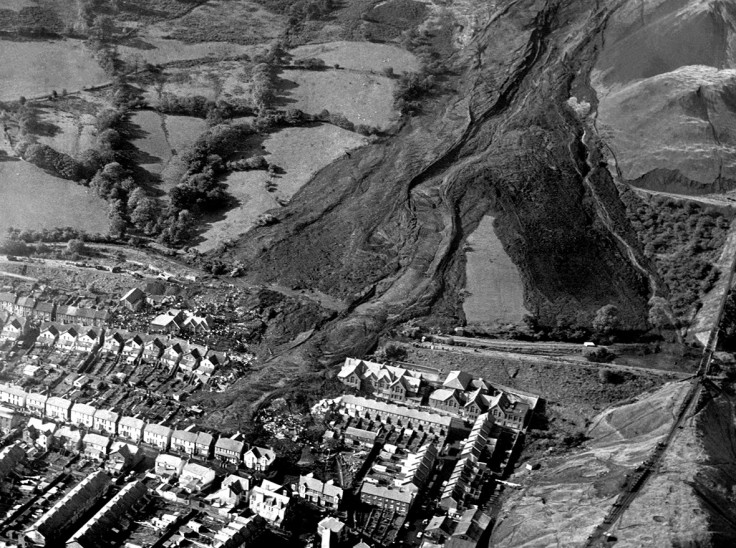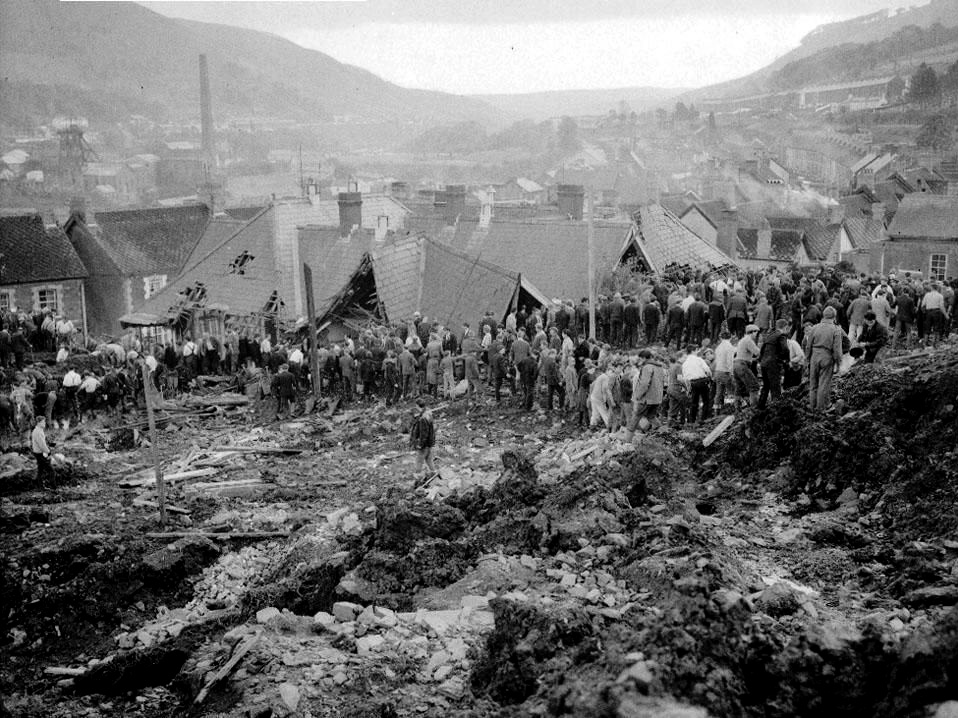Aberfan: 50th anniversary of mining disaster that wiped out a generation
Fifty years on from the tragedy, we look back at one of the darkest days in modern Welsh history.
On 21 October 1966, an avalanche of coal waste hit the mining village of Aberfan in south Wales, killing 116 children and 28 adults. More than 150,000 tonnes of excavated mining debris from the Merthyr Vale Colliery came thundering down a hillside, smashing into a school and nearby houses with tsunami-like force.

The waste material had been piled high on the side of Mynydd Merthyr for years even though there were numerous underground springs below. When mine workers arrived at work at 7am on 21 October, they found that tip number seven had sunk around three metres (10 feet) overnight. With no phone lines on the hillside, a worker walked down the mountain to tell bosses about the sinking problem. By the time the order to stop adding to the tip was given it had sunk six metres (19.5 feet). By now the school bell had rung at Pantglas and 240 pupils were inside in an excited mood on what was their last day before half term.


At 9.15am, the tip gave way and 150,000 tonnes of liquefied slurry slid down the mountain towards the village of Aberfan. The avalanche fractured two pipelines and sent hundreds of gallons of water rushing into already saturated sludge. The slurry hit the school and houses on Moy Road with almighty force. A whole class of 34 juniors were among those who perished.

Firefighters, emergency services and miners began the battle to dig out those trapped by the debris. Five children were miraculously dug out alive after they had been shielded from the brunt of impact by dinner lady Nansi Williams. The last survivor, Jeff Edwards, was pulled out from the rubble between 11am and midday. He had been pinned for more than two hours with the head of a dead girl against him.

As news of the disaster emerged, miners, servicemen and residents from neighbouring communities rushed to Aberfan to help with the rescue effort, forming a conveyor belt of "bucket brigades" to help move the waste away quicker. Hope of finding more survivors faded as rescuers pulled out dead child after dead child. Eyewitnesses later described seeing the children still sitting at their desks, entombed by the slurry. The disaster all but wiped out an entire generation of the community's schoolchildren.













On 27 October, a mass funeral for 81 children was held in the steep hillside cemetery overlooking the site of the disaster. Long rows of small pine coffins were lowered into two mass graves only half a mile from the school where these children had played – and where they died. All work at the disaster site stopped for the first time in six days, and silence fell over the valley, which, ever since the mountain of sludge descended, had echoed day and night to the noise of Britain's biggest-ever rescue operation at that time.



The man-made disaster was all the more painful to deal with given that there had been previous concerns from villagers. A year before the tragedy unfolded, two mothers had presented Pantglas junior school headmistress Ann Jennings with a petition about flooding, and she had passed it on to the local council. In 1964, a local councillor – Gwyneth Williams – had said that if tip were to move suddenly it could threaten the whole school. However, the warnings were ignored.
Despite an in-depth tribunal, which cited the disaster had been caused by a "bungling ineptitude" by the Coal Board, no one was ever punished. To add insult to injury, after a protracted row over the cost of removing Tip Number Seven, scared villagers had little choice but to pay out £150,000 from a disaster fund. The money was eventually repaid in 1997. The Welsh government went one step further 10 years on by donating £1.5 million to the Aberfan Memorial Charity.
A memorial garden now stands where the children from Pantglas Junior school were singing at the last school assembly.





Time has healed some of the scars, but the events of that day and its horrendous aftermath and fight for justice have not been forgotten in Wales. On Friday 21 October, the Welsh Assembly will fly its flags at half mast as a mark of respect to those left devastated by the disaster. And at 9.15am people will observe a minute's silence.
First Minister Carwyn Jones said: "The disaster in Aberfan was one of the darkest days in modern Welsh history and we remember the adults and school children who lost their lives. We also think about the survivors, those who lost loved ones and the people who answered the call to search and care for survivors, and recover those who had perished. Individuals, families and the community have been profoundly affected by the disaster. Half a century after, it is fitting that the country as a whole comes together, with respect and compassion, to remember."
© Copyright IBTimes 2025. All rights reserved.






















